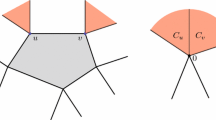Abstract
In this paper we consider a linear programming problem with the underlying matrix unimodular, and the other data integer. Given arbitrary near optimum feasible solutions to the primal and the dual problems, we obtain conditions under which statements can be made about the value of certain variables in optimal vertices. Such results have applications to the problem of determining the stopping criterion in interior point methods like the primal—dual affine scaling method and the path following methods for linear programming.
Similar content being viewed by others
References
C. Choi, C.L. Monma and D. Shanno, “Further development of primal—dual interior point methods,”ORSA Journal on Computing 2(4) (1990) 304–311.
A.J. Hoffman and J.B. Kruskal, “Integral boundary points of convex polyhedra,” in: H.W. Kuhn and A.W. Tucker, eds.,Linear Inequalities and Related Systems (Princeton University Press, Princeton, NJ, 1956) pp. 223–246.
N. Karmarkar, “A new polynomial-time algorithm for linear programming,”Combinatorica 4 (1984) 373–395.
M. Kojima, S. Mizuno and A. Yoshise, “A primal—dual interior point algorithm for linear programming,” in: N. Mediddo, ed.,Progress in Mathematical Programming, Interior Point and Related Methods (Springer, New York, 1988) pp. 29–47.
M. Kojima, S. Mizuno and A. Yoshise, “A polynomial-time algorithm for a class of linear complementarity problems,”Mathematical Programming 44 (1989) 1–26.
M. Kojima, S. Mizuno and A. Yoshise, “An O(\(\sqrt n \) L) iteration potential reduction algorithm for linear complementarity problems,”Mathematical Programming 50 (1991) 331–342.
K. Masuzawa, S. Mizuno and M. Mori, “A polynomial time interior point algorithm for minimum cost flow problems,”Journal of the Operations Research Society of Japan 33 (1990) 157–167.
S. Mizuno and K. Masuzawa, “Polynomial time interior point algorithms for transportation problems,”Journal of the Operations Research Society of Japan 32 (1989) 371–382.
R.C. Monteiro and I. Adler, “Interior path following primal—dual algorithms. Part I: Linear programming,”Mathematical Programming 44 (1989) 27–42.
R. Saigal, “Tracing homotopy paths in polynomial time,” Class notes (1988).
R. Saigal, Private communication (1989).
Y. Ye, “An O(n 3 L) potential reduction algorithm for linear programming,”Mathematical Programming 50 (1991) 239–258.
Author information
Authors and Affiliations
Additional information
This author's research is partially supported by NSF grant DDM-8921835 and Airforce Grant AFSOR-88-0088.
Rights and permissions
About this article
Cite this article
Mizuno, S., Saigal, R. & Orlin, J.B. Determination of optimal vertices from feasible solutions in unimodular linear programming. Mathematical Programming 59, 23–31 (1993). https://doi.org/10.1007/BF01581235
Received:
Revised:
Issue Date:
DOI: https://doi.org/10.1007/BF01581235




